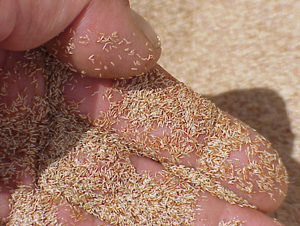 Grass Seed
Grass Seed
 Grass Seed
Grass Seed
A range of grasses are used to build and maintain greens, tees, collars, approaches, fairways, lawns and general turf. In northern climates bentgrass is commonly used for greens, tees, collars, approaches and fairways. Blends of bluegrass, rye and fescue plus a range of other varieties are used on lawns and general turf.
There are many varieties of bentgrass, each hybridized for a specific purpose. The seed is very fine covers a large area.
 Penncross
Creeping Bentgrass
Penncross
Creeping Bentgrass
Penncross is designed for extensively managed golf greens, tees, and fairways and awn bowling surfaces. Aggressiveness, vigor, and wear tolerance make Penncross a natural. Its ability to perform under a wide range of conditions makes this bentgrass adaptable virtually worldwide. Golf course architects have specified Penncross for areas of extreme cold and heat, and Penncross has survived humidity where bermuda grass used to be the standard.
Penncross performs best in soils with a pH of 5.5 to 8. It has a moderate nitrogen requirement with 1-2 pounds of actual N per 1,000 square feet per year adequate in most situations. Penncross' optimum mowing height is 3/16 to 5/16 inch but can be adjusted higher or lower depending upon maintenance practices and intended use. Penncross performs best on a sandy soil and tolerates clay soils with adequate drainage. Most bentgrasses do not perform well in wet areas, however, Penncross can tolerate saturated soil conditions for short periods of time.
Penncross can be seeded from 1-2 pounds per 1,000 square feet depending on the application. Cover seed to a depth not exceeding ¼" and keep seedlings moist until well rooted. Germination will take place in 7-15 days depending on soil temperatures, and the first mowing may be expected within 30 days, or when the plants have sufficiently rooted. Mow at a 3/4" height of cut or lower until turf is established. Limited use of the area can be expected in 6 weeks.
www.puttgarden.com